The various types of climbing on rock and ice
There are various types of climbing, and each requires a number of different tools and skills. Activities from just hiking up a steep slope of a rocky mountainside to ascending vertical cliffs are defined as climbing. Technical climbing, which requires equipment for belaying, climbing on indoor walls designed especially for the purpose, to the extreme sport of ice climbing, all fall under the general heading.
Rock climbing is an activity which can be done outside in a natural environment on actual rock or indoors at a climbing gym. Climbing is often done in groups of two or more climbers using equipment such as carabiners, cams, rope, quickdraws, rock shoes, and harnesses.
Here, climbers need to call on a set of basic skills such as belaying and rappelling or holding a rope for a partner climber. Rappelling is where a climber slides down a rope in a controlled manner.
Climbing disciplines
With rock climbing, there are three main disciplines:
- sports climbing,
- bouldering,
- traditional (‘trad’) climbing.
Traditional climbing
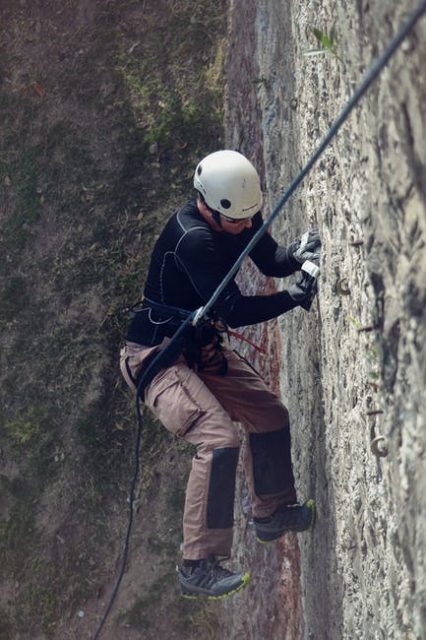
With traditional climbing, the climber climbs cliffs and rock walls using gear that is installed and then removed by those climbing in the group. This is the original (hence traditional) form, and it impacts the rock less than other methods as the climbing aids used on a route, such as cams and nuts, are removed from their placements in the rock once the route is finished. This type of climbing is also known as adventure climbing as the group begins at the bottom of a cliff and aims for the summit. At intervals called pitches, the members of the group use belaying to help the other parties to climb the next section.
Sports climbing
On the other hand, sports climbing is where permanent anchors are installed in the rock face. These holds have been placed by using a hand drill or a battery powered drill and then placing robust construction bolts into the holes. A bolt hanger is attached for clipping on a carabiner. This style of climbing is a great introduction to climbing as most routes are less than 100 feet long. Climbers ascend one by one by lead-climbing or top-roping the route, ending at bolted anchors that have been placed part of the way up the cliff. The belayer then lowers them back down from these anchors. Sports climbing emphasizes a gymnastic ability of movement.
Bouldering
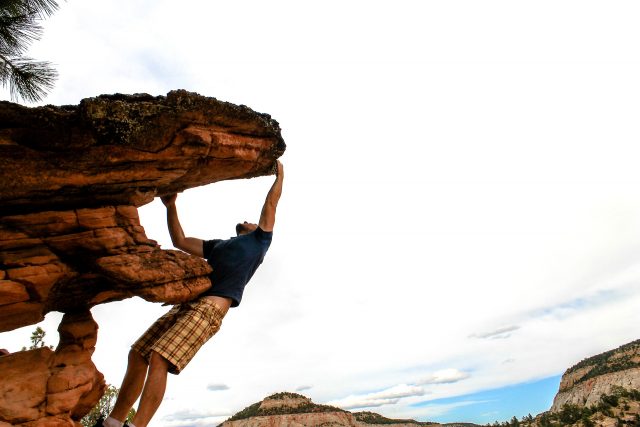
Boulderingis a technique that does not require ropes. It is where climbers attempt to ascend boulders and small cliffs with short routes. Bouldering often involves hard moves near the ground. Ropes can be used on highball challenges. When climbers are training, a thick layer of foam called a crash pad is placed directly below the more challenging areas for a safer landing in the case of slipping. This is a good method of solo training.
Climbing styles
Top-roping
New climbers usually begin with climbing with a Top-roping style of climbing. This is the case on both natural rock or man-made walls. Climbing indoors is commonly performed using this method. The top-rope is initially set up by a climber at the front of a trad route or a sports route, going from the base up to a set of anchors. The rope is attached with locking carabiners. Or it is set up by going from the side to the summit of the cliff, where the front climber builds an anchor and then attaches a rope with carabiners.
Free solo climbing
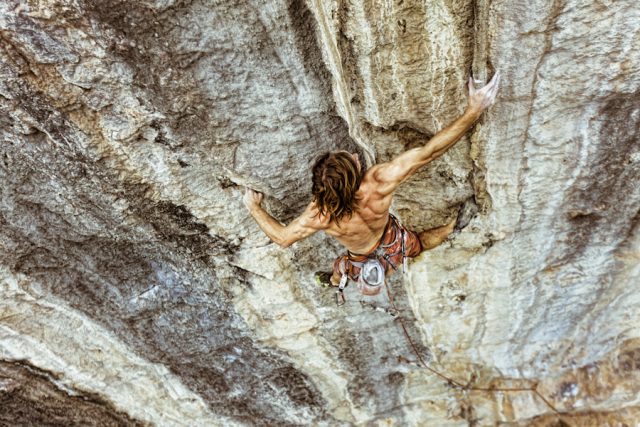
Soloing or Free solo climbing is climbing without any equipment at all, not even a rope. The only things used are a chalk bag and rock shoes. This type of climbing is very risky, it needs a very cool head and a great deal of skill. Falling from a cliff in this case with no safety devices will invariably result in severe injury if not death. This style of climbing should not be attempted by anyone other than the most experienced of climbers.
Scrambling
Scrambling is a style of climbing that requires only the most basic ability. A climber must use hands and feet and use their skills at rappelling, descending and belaying. This is a fun way to learn climbing, but the climber must be careful to not wander off route where the more difficult climbing terrain is.
Aid climbing
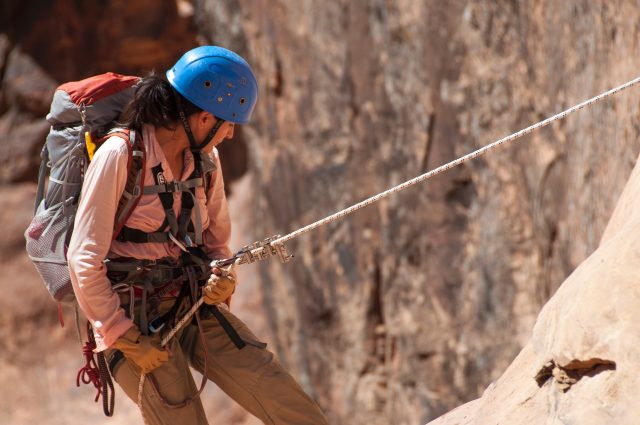
Then there is Aid climbing which is the opposite of free climbing as it involves the use of specialized equipment. There is upward progress by mechanical means where free climbing makes use of hands and feet.
Anything to get to the top is acceptable with this style. Ropes, pitons, cams, and nuts are all used. In the case of a free climber grabbing onto a carabiner or any other equipment, this is called a French free move and is considered an aid.
Indoor climbing
Indoor climbing is done on specifically built climbing walls where a wall has been designed with foot and handholds. These are found in climbing gyms. These gyms are a great place to learn the skills needed for the sport, such as how to move, the way to use the handholds and how to properly apply the footwork. Also how to lower down and how to belay. Such gyms mainly have walls where top-rope climbs are done. Here the rope is always attached above the climber so that the climber is protected from dangerous falls. Most of these gyms will have several lead routes to enable a climber to learn this method of climbing once they’ve got the skills needed for top-roping.
Alpinism
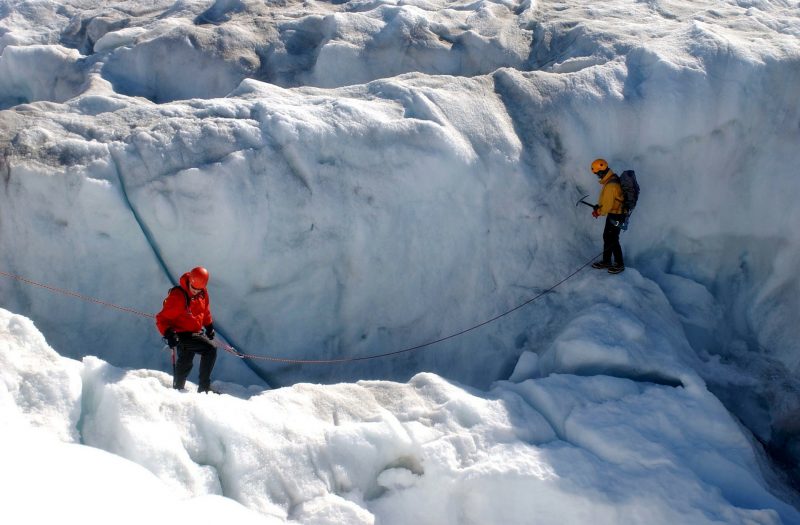
Mountaineering Alpine climbing, or Alpinism, is when climbers head for mountains such as the Himalayas or the Rockies. Here, ice climbing and rock climbing skills are called for. These adventures could just be steep hikes or can be as complicated as snow and ice climbing needing special tools like an ice ax and crampons. Proper mountaineering needs the use of many outdoor climbing skills. From route finding to rappelling, belaying and descending. Weather forecasting and knowledge about avalanche safety is also an advantage.
Ice climbing
Finally, the hard one! Ice climbing. Here climbers scale frozen waterfalls and icy gullies using specialist tools. The climbs are intense and risky. The climber has to rely on the equipment he has and his skill in using it.
If you have any comments then please drop us a message on our Outdoor Revival Facebook page
If you have a good story to tell or blog let us know about it on our FB page, we’re also happy for article or review submissions, we’d love to hear from you.
We live in a beautiful world, get out there and enjoy it. Outdoor Revival – Reconnecting us all with the Outdoors.





